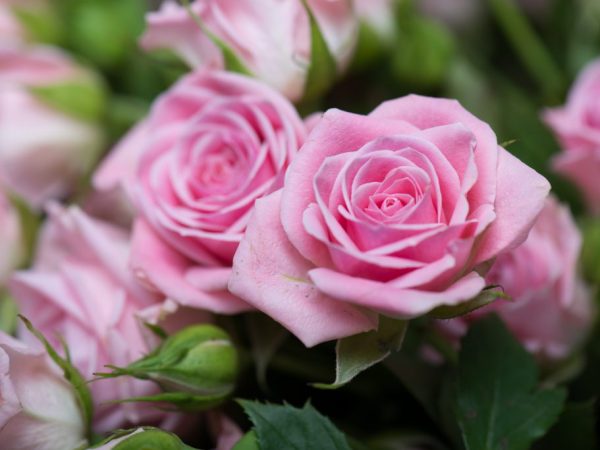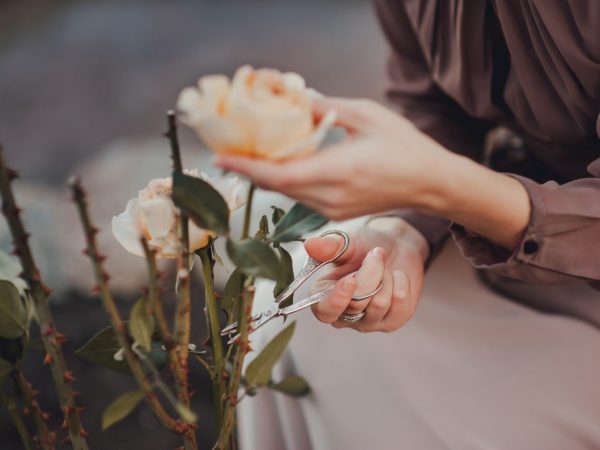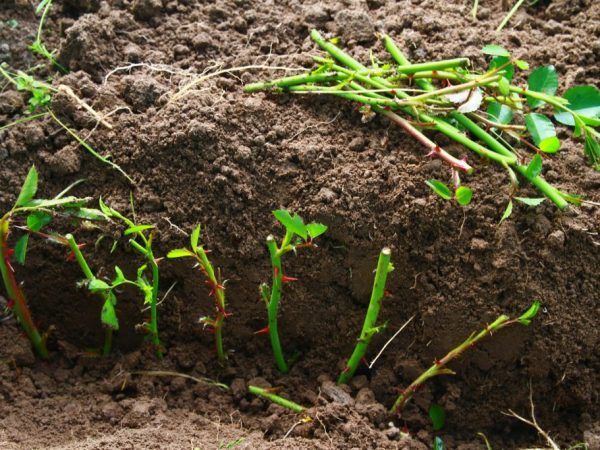Autumn cuttings of a rose - we propagate at home
Reproduction of roses by cuttings allows you to get good planting material at home. Autumn breeding has a number of advantages and is suitable for different varieties. Harvesting and rooting are carried out on time.

Autumn cuttings of a rose - we propagate at home
Benefits of autumn cuttings
Autumn cuttings of roses is the easiest way to propagate, it is suitable for most species, including:
- ground cover;
- semi-pebble;
- curly;
- dwarf;
- climbing;
- certain types of scrubs.
The method is not used for tea bush varieties, which have a minimal chance of survival.
Timing
The time for grafting coincides with the autumn pruning (this usually happens at the time of the first night cold snaps, when it is still warm during the day and the temperature drops below 0 ° C at night).
More precise terms depend on regional characteristics:
- for the middle zone and the Moscow region, the Volga region and the Leningrad region, they begin to propagate the rose from October;
- in the Urals, Siberia and other northern areas — from late August to early September to mid-October;
- in the south, the procedure is postponed to the end of the season, October-November.
With the subsequent planting of shoots in open ground, which is often practiced in the south, the period of harvesting the planting material and its rooting must be shifted to the end of summer - the beginning of autumn, so that the adaptation stage ends before the arrival of winter.
Rules for cutting cuttings
For reproduction, blanks from mature plants with certain parameters are suitable:
- diameter from 0.5 cm;
- the presence of at least 3 developed kidneys.
Cuttings must be cut at 15-25 cm. In the upper part, a straight cut is made, at a distance of 2-3 cm from the growth site of the apical bud, and from the bottom - cut obliquely, at an angle of 45 °, 1 cm below the location of the lower kidney.
Slices from different angles help define the top and bottom of the cuttings when planting.
The maturity of a rose is determined by its thorns: if they break easily when pressed, the plant does not fit.
During the procedure, a sharp instrument that has undergone preliminary disinfection is used. from the use of a blunt object or scissors, a lacerated wound with raised edges is formed, which reduces the chances of survival. Such a workpiece will be difficult to root.
Home rooting rules
To plant material for rooting, you need a suitable container and a fertile substrate.
Pot

A mature plant is subject to cuttings.
Planting pots should be small in volume, up to 0.5 liters. The most suitable option is cut plastic bottles. An important condition for the use of containers is the presence of drainage holes.
When choosing containers for rooting cuttings, it is better to take transparent ones, through the walls of which the formation of roots will be noticeable.
Substrate
The rose requires a loose, fertile substrate, purchased from a gardening store, intended for growing the Rosaceae family. The finished soil mixture is diluted with river sand in a ratio of 1: 2.
Perlite or vermiculite helps to increase air permeability. Sphagnum is useful for rooting, which prevents decay of fresh and weak roots and improves soil aeration.
Before planting the cuttings, the substrate is disinfected using watering with aqueous solutions of Fitosporin and deepening of the Glyocladin tablet. Ordinary potassium permanganate can replace drugs.
Pre-planting preparation
Before rooting, the cut planting material is treated with stimulating drugs - root formers.
For these purposes, the following are suitable:
- honey mixture - 1 tsp honey in 200 ml of water, the ends of the blanks are immersed for 10-12 hours;
- ready-made root-forming agents Kornevin, Zircon and similar ones are diluted according to the instructions, the processing time is up to 12 hours.
Landing technology
Before planting in the soil mixture, cuttings can be germinated in water. They do this in order to accelerate the survival rate.
Those blanks that have formed roots up to 1 cm or more in length are planted in a pot:
- sprouts are stuck into the prepared substrate at a slight angle to a depth of 3 cm at a distance of 10-15 cm from each other, leaving 1-2 buds on the surface;
- watering is carried out with warm water;
- a thin layer of river sand is poured to avoid crust formation ;:
- a protection from a cut plastic bottle is installed on top, covered with a glass or glass jar, creating a greenhouse microclimate;
- put the pot in a well-lit place with diffused light and a temperature of at least 22-25 ° C, in the absence of direct sunlight and drafts.
After planting, the cuttings are aired daily and watered as the soil dries.
The duration of the rooting of blanks is up to 2 months. When leaves appear and roots form, the protection is removed from the container.
Before transplanting into a greenhouse or open ground, the sprouts are kept in a cool place at a temperature of 15-18 ° C. This will prevent them from over-stretching.
With the active growth of the green mass of roses, they are sprayed with preparations from pests, for example, Fitoverm. Most often, a spider mite settles on a plant grown at home.
Time to transplant into the ground

In spring, seedlings can be transplanted into the ground
Rooted blanks are transplanted to a permanent place at the onset of spring, when warm weather sets in, around April-May. Only strong and strengthened seedlings are suitable for transplantation.
Weak plants are kept at home until they are strengthened.
Landing technology:
- choose a place, optimal - constant, so that at the next transplant not to cause another stress to the rose;
- the planting hole is dug to a depth of 0.3 m, filled with grass, sprinkled with compost on top;
- a rooted stalk is inserted into the substrate at an angle of 45 °, deepening by 2/3 of the length, leaving 1-2 buds on the surface
For the winter, the sprout must be covered with a glass jar or a plastic bottle, the base of which is covered with leaves, sawdust or straw. In regions with snowless winters, the protection is covered with soil to the upper level and covered with a covering material.
The result of a successful rooting of a rose in open ground will become noticeable in the spring, when foliage appears and begins to actively grow on the sprout.
Storage of workpieces in winter
When there is no need for autumn planting, the blanks are left for the winter for subsequent rooting.
Preservation methods:
- The shoots are wrapped in lutrasil, polyethylene or spunbond and buried in the garden in the ground to a depth of 0.3 m. The main condition is to pack the branches separately, excluding their close contact.
- The ends of the blanks are dipped into molten paraffin, wrapped in a cloth and folded into a cardboard box, which is also dropped into the garden soil to the required depth.
Burrito method: shoots from a donated bouquet, in which the buds have wilted, are treated with Previkur at the ends, covered with paper, moistened and stored in polyethylene bags without tying them to ensure air penetration.
The sprouts are placed in a darkened room at a temperature of about 18-20 ° C. Bags should be opened regularly to check for mold. When dry, spray with water. When roots appear, they are planted at home and kept until spring.
With any selected method, the blanks to be stored for winter are pre-cleaned from foliage.
Practical tips for growing
Rose is a rather capricious plant. In order to achieve a positive result with cuttings and increase the survival rate, it is worth listening to a number of tips from experienced florists.
- The best workpiece for breeding will be a stalk with a so-called heel - a piece of wood. These sprouts are not cut, but broken off. On the heels at the site of injury, a protective growth is more actively formed - callus. Growing a rose from such cuttings is better and faster.
- For autumn cultivation, flower growers recommend leaving 2 to 4 leaves on the processes in the upper part. They will become an additional power source for the layer.
- To increase the safety of branches during wintering, dipping the ends into melted wax and then into cold water for solidification helps.
- In the fall, cuttings are planted with a double margin: with the intention to get 5 adult established plants, 7-10 blanks are rooted.
- When the cuttings are blackened during rooting, the earth is watered with Fitosporin (1 tsp / 1 l of water).
Summing up
You can cut a park or garden rose in the fall. Rooting is carried out at home.
It is possible to plant shoots with a formed root system immediately in open ground in regions warm in climate, or in a greenhouse and cover for the winter, or leave for storage and plant in the ground in spring. Tips from experienced florists will help to avoid mistakes.

